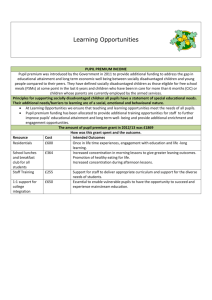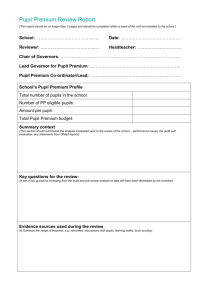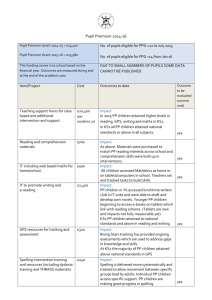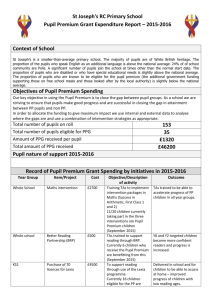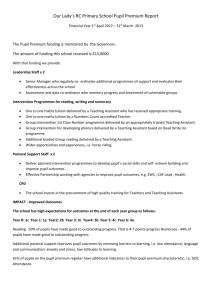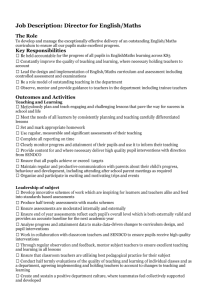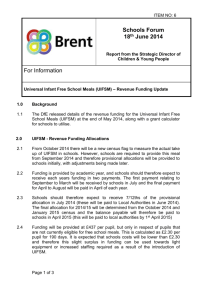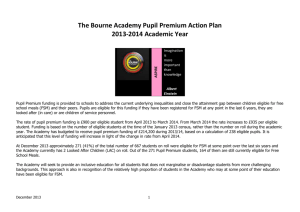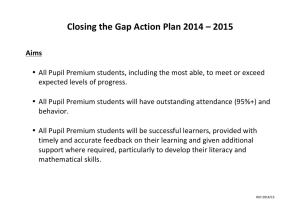Pupil Premium Report
advertisement
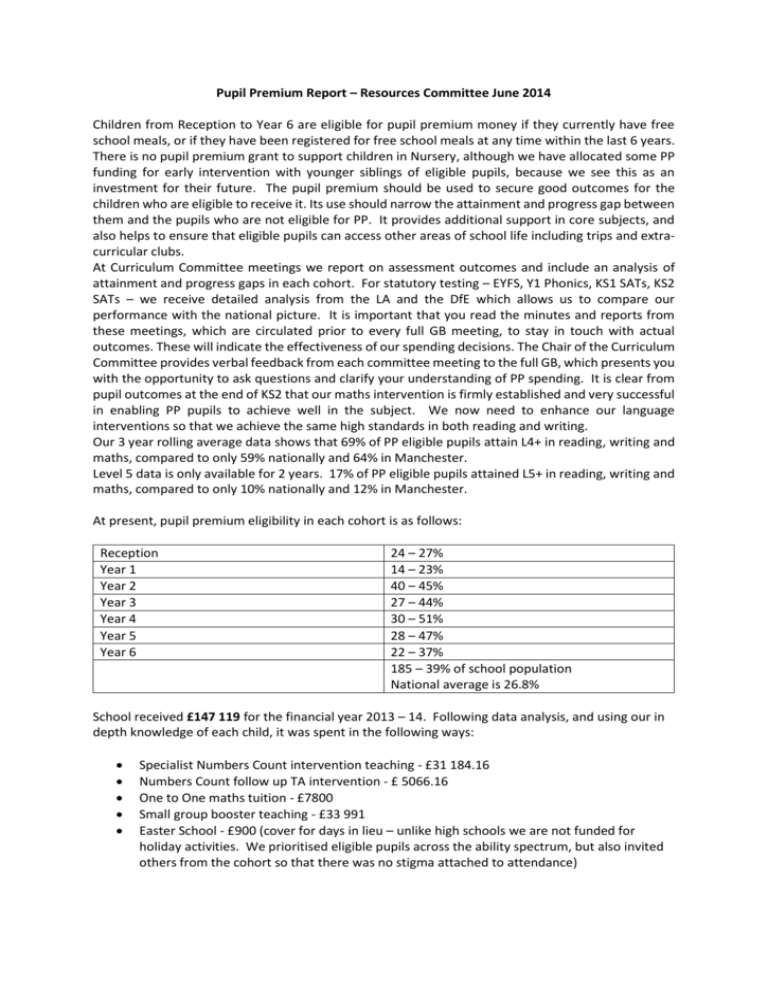
Pupil Premium Report – Resources Committee June 2014 Children from Reception to Year 6 are eligible for pupil premium money if they currently have free school meals, or if they have been registered for free school meals at any time within the last 6 years. There is no pupil premium grant to support children in Nursery, although we have allocated some PP funding for early intervention with younger siblings of eligible pupils, because we see this as an investment for their future. The pupil premium should be used to secure good outcomes for the children who are eligible to receive it. Its use should narrow the attainment and progress gap between them and the pupils who are not eligible for PP. It provides additional support in core subjects, and also helps to ensure that eligible pupils can access other areas of school life including trips and extracurricular clubs. At Curriculum Committee meetings we report on assessment outcomes and include an analysis of attainment and progress gaps in each cohort. For statutory testing – EYFS, Y1 Phonics, KS1 SATs, KS2 SATs – we receive detailed analysis from the LA and the DfE which allows us to compare our performance with the national picture. It is important that you read the minutes and reports from these meetings, which are circulated prior to every full GB meeting, to stay in touch with actual outcomes. These will indicate the effectiveness of our spending decisions. The Chair of the Curriculum Committee provides verbal feedback from each committee meeting to the full GB, which presents you with the opportunity to ask questions and clarify your understanding of PP spending. It is clear from pupil outcomes at the end of KS2 that our maths intervention is firmly established and very successful in enabling PP pupils to achieve well in the subject. We now need to enhance our language interventions so that we achieve the same high standards in both reading and writing. Our 3 year rolling average data shows that 69% of PP eligible pupils attain L4+ in reading, writing and maths, compared to only 59% nationally and 64% in Manchester. Level 5 data is only available for 2 years. 17% of PP eligible pupils attained L5+ in reading, writing and maths, compared to only 10% nationally and 12% in Manchester. At present, pupil premium eligibility in each cohort is as follows: Reception Year 1 Year 2 Year 3 Year 4 Year 5 Year 6 24 – 27% 14 – 23% 40 – 45% 27 – 44% 30 – 51% 28 – 47% 22 – 37% 185 – 39% of school population National average is 26.8% School received £147 119 for the financial year 2013 – 14. Following data analysis, and using our in depth knowledge of each child, it was spent in the following ways: Specialist Numbers Count intervention teaching - £31 184.16 Numbers Count follow up TA intervention - £ 5066.16 One to One maths tuition - £7800 Small group booster teaching - £33 991 Easter School - £900 (cover for days in lieu – unlike high schools we are not funded for holiday activities. We prioritised eligible pupils across the ability spectrum, but also invited others from the cohort so that there was no stigma attached to attendance) TA 3 to support Y2 ‘spike’ class - £9277.33 - 57% of this class are eligible for PP; in addition, most came to school as INAs or as children who had been out of the school system for >6 months. Reading interventions - £21 495.10 Support for Siemens reading project - £1378 Motor skills support - £4084.90 Draw & Talk sessions - £1154.80 5 minute box sessions - £6175 Early intervention - £5700 School trips subsidy - £4326.72 School clubs subsidy - £2114 Free school meals subsidy * - £9385.17 Sundries - £200 (shoes, uniform items) Debt write off £1500 (school meals, out of hours care, lost library books etc) Total spent on addressing disadvantage: £146 732.34 Underspend of £1386.66 (0.9%) *The local authority pays £1.79 per meal to school. The actual meal cost is £2.10, which leaves us with a shortfall of 31p per meal, because we are obliged to serve a free school meal to every pupil whose parent/carer has applied for and been given the benefit. Roisin Hanly has been appointed to a TLR and from 01/09/14 she will have the responsibility of working with colleagues to track the effective and targeted of our use of pupil premium funding. One of the systems we can develop is an anonymised spreadsheet to show you the spending breakdown in more detail if required. It is quite a task to break down all the different elements of support we provide with the associated salaries. It is made more complex still because the PP is payable from 1st April to 31st March, but final assessment of pupil outcomes is completed in July, thus straddling 2 financial years! Academy funding runs from 1st Sept to 31st August, which is more logical for schools.



